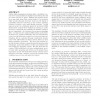Free Online Productivity Tools
i2Speak
i2Symbol
i2OCR
iTex2Img
iWeb2Print
iWeb2Shot
i2Type
iPdf2Split
iPdf2Merge
i2Bopomofo
i2Arabic
i2Style
i2Image
i2PDF
iLatex2Rtf
Sci2ools
NSPW
2004
ACM
2004
ACM
Support for multi-level security policies in DRM architectures
Digital rights management systems allow copyrighted content to be commercialized in digital format without the risk of revenue loss due to piracy. Making such systems secure is no easy task, given that content needs to be protected while accessed through electronic devices in the hands of potentially malicious end-users; in this context, intrusion tolerance becomes a very useful system property. In this paper we point out a limitation shared by all current DRM architectures, namely their weakness in reacting to possible device compromise and confining the damage caused by such a compromise. As a solution, we propose a paradigm shift - moving from the original DRM system model where all devices are equally trustworthy and have discretionary control over all protected content, to a new model where information flow is controlled through a multi-level security policy that differentiates between devices based on their tamper-resistance properties. We show that besides improved intrusion...
| Added | 30 Jun 2010 |
| Updated | 30 Jun 2010 |
| Type | Conference |
| Year | 2004 |
| Where | NSPW |
| Authors | Bogdan C. Popescu, Bruno Crispo, Andrew S. Tanenbaum |
Comments (0)

